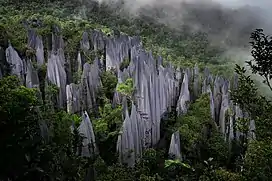| Mount Api | |
|---|---|
 The limestone pinnacles of Mount Api | |
| Highest point | |
| Elevation | 1,750 m (5,740 ft) |
| Coordinates | 04°06′07″N 114°53′35″E / 4.10194°N 114.89306°E |
| Geography | |
| Location | Sarawak, Borneo |
Mount Api (Malay: Gunung Api) is a limestone mountain located in Gunung Mulu National Park in Sarawak, Malaysia. Neighbouring Mount Benarat and Mount Buda are part of the same formation. Mount Api is famous for its striking limestone karst formations, commonly called "the pinnacles".[1][2]
The mountain is host to many caves, with passages linking to the massive Clearwater Cave system.[3] Api Chamber, the second-largest chamber in Malaysia, was discovered on Mount Api during the Benarat 2005 Caving Expedition.
Mount Api is notable for its pitcher plant diversity, which includes at least eight species: Nepenthes campanulata, Nepenthes faizaliana, Nepenthes hurrelliana, Nepenthes lowii, Nepenthes muluensis, Nepenthes tentaculata, Nepenthes veitchii, and Nepenthes vogelii.[2]
See also
References
- ↑ Waltham, T. 1995. The Pinnacle Karst of Gunung Api, Mulu, Sarawak. Cave and Karst Science 22(3): 123–126.
- 1 2 Bourke, G. 2011. The Nepenthes of Mulu National Park. Carniflora Australis 8(1): 20–31.
- ↑ White, William Blaine; Culver, David C. (2012). Encyclopedia of Caves. Academic Press. pp. 532–533. ISBN 978-0-12-383832-2.